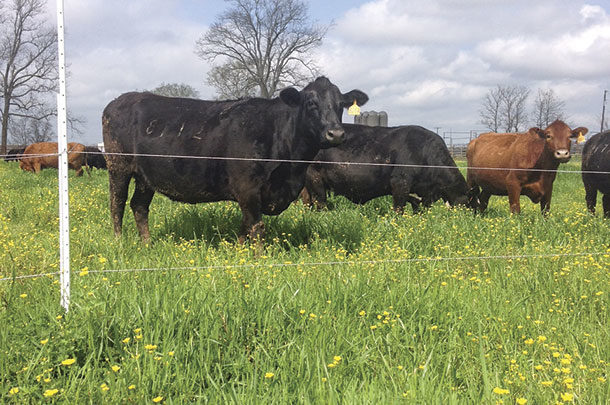Whether this is a result of increased awareness of the effects on our surroundings or simply the desire to be efficient and profitable, our decisions should reflect sound production as well as environmental considerations. Implementing best management practices (BMPs) in our operation can be beneficial over time.
BMPs vary depending on the type of operation, but should include practices that reduce soil and nutrient loss, protect against contamination of surface and groundwater, and are economically feasible while sustaining and improving your operation. For the forage producer, (if you are raising cattle you are a forage producer by default) losing nutrients can be costly, especially when applying nitrogen.
Nitrogen loss
Nitrogen (N) is crucial to the establishment and growth of forages. Inadequate amounts of N can result in low crude-protein levels, lower yields and eventual loss of stand in some grasses. While varying amounts of N can be obtained by the plant through several sources, such as fixation from legumes or organic N from manure decomposition, most pasture forages will need repeated applications of a commercial N fertilizer.
As with any input in our operation, we want to be sure we are getting the most return on our investment while being mindful of potentially adverse effects. Nitrogen loss can occur several ways and should be a primary concern in nutrient management.
Denitrification can occur in saturated soils when bacteria convert nitrate in the soil to a gaseous form of N, which is lost through the soil surface.
Leaching is most prevalent in well-drained soils where nitrates are not bound to soil particles and can get carried away through water movement. Excessive rainfall and low crop utilization create ideal conditions for leaching.
Volatilization occurs primarily when manure or ammonium-based fertilizers such as urea (46-0-0) undergo conversion to ammonia gas on the soil surface, and N is then lost into the atmosphere rather than the ammonium being converted to nitrate in the soil where it is protected and able to bind to soil particles. Wet soils, warm temperatures and high soil pH greatly increase potential for volatilization.
Incorporation of nitrogen into the soil through plowing, irrigation or rainfall can significantly reduce volatilization if done soon after application. Even though many factors affect the rate at which nitrogen can be lost, there are effective tools that can be used to mitigate nutrient loss including various planting methods, timing and rate of fertilizer application, and selecting suitable nitrogen sources.
Polymer-coated urea
Recent studies were conducted at the Louisiana State University AgCenter Dean Lee Research and Extension Center in Alexandria, Louisiana, that focused on the use of a polymer-coated urea (PCU) as a nitrogen source in winter and summer forage systems.
Urea has always been an excellent source of nitrogen due to its high percentage of N by weight (46 percent). Generally, it is less expensive per pound of N than other solid materials and is readily available at most fertilizer vendors.
Fertilizer costs are a large factor in selecting nitrogen sources, and urea prices can fluctuate with season and domestic production. The cost of urea at the time of these studies was approximately 40 cents per pound of N. However, because urea can be very susceptible to volatilization, options may include using a controlled-release urea product or added nitrogen stabilizer to combat this potential loss.
Nitrogen stabilizers generally contain a urease inhibitor that slows the nitrification of the urea for approximately 10 to 14 days if left unprotected on the soil surface. Polymer-coated urea products are urea prills encapsulated with a coating that acts as a semi-permeable membrane. Water moves through the coating and dissolves the prill into solution that is released into the soil over time.
Permeability is dependent on adequate moisture and warm temperatures, thereby protecting N from adverse soil and weather conditions.
In the fall of 2015, trials began that included both a winter ryegrass (lolium) and a summer hayfield component, primarily Alicia bermudagrass (Cynadon dactylon). Fertilizer treatments included urea (U), urea treated with a nitrogen stabilizer (UNS) and a PCU. For this particular study, the use of a urease inhibitor added 7 cents per pound of N above untreated urea. The polymer-coated product increased by 13 cents per pound more than urea.
For the winter season, annual ryegrass was planted into prepared seedbeds in late September and all plots received a total of 150 pounds of N per acre over the grazing season. PCU plots received half of total N at planting and the balance during the first week of January. Initial applications of U and UNS were made to those respective plots after ryegrass reached 3 to 4 inches in height at a rate of 30 pounds of N per acre.
Mature cows were allowed to graze plots when heights reached 8 to 10 inches for grass removal, and forage samples were taken prior to each grazing and analyzed for nutritive value and yield. Subsequent applications of U and UNS were made to those plots after each grazing event, also at 30 pounds of N per acre.
Although the results showed no significant differences in quality or average dry matter at each grazing (Figure 1), the PCU plots reached grazing height 10 days sooner than other treatments and recovered within 21 days after the first grazing. Because of this, those plots were grazed a total of six times by April 30, compared to five times on the U and UNS treatments.

The summer hay component included the same nitrogen sources, with the recommended 200 pounds per acre of N applied for the growing season. The study began in late May with the initial N application. The PCU plots received half of the required N at the start and the balance after the second hay cutting. To initiate growth in the PCU plots, a blend of 60 percent PCU and 40 percent U was applied.
Plots with U and UNS received N in three equal amounts beginning in May, then following the first and second cuttings. Forage samples were collected prior to cuttings (approximately 30-day intervals) and showed no differences in quality or yield across treatments.
Summary
While this study reflects one year of data in one location, it should prompt us to consider several things. The PCU plots provided more grazing in the ryegrass study. Quick establishment along with low recovery time after the first time grazed allowed this to occur early in the season. However, no effect was seen in the summer hay trials.
The PCU plots received all N in two applications, which resulted in fewer trips over the field. The PCU may also guard against a potentially lost opportunity to apply nitrogen due to adverse weather or wet field conditions.
Lastly, the characteristics of the polymer-coating product allow it to slow or stop release of N when weather and soil conditions are unfavorable, and therefore supply N under optimum growing conditions. As mentioned, increased knowledge and new technology should allow us to make better decisions in our operation.
Polymer-coated urea products may prove to be beneficial for the beef producer, favorable for the environment and worth a second look. ![]()
PHOTO: Cows graze ryegrass plots at the Dean Lee Research Station in Alexandria, Louisiana. Photo by Jeff Gurie.

-
Jeff Gurie
- Research Associate / Livestock Farm Manager
- Dean Lee Research Station
- Louisiana State University
- Email Jeff Gurie











